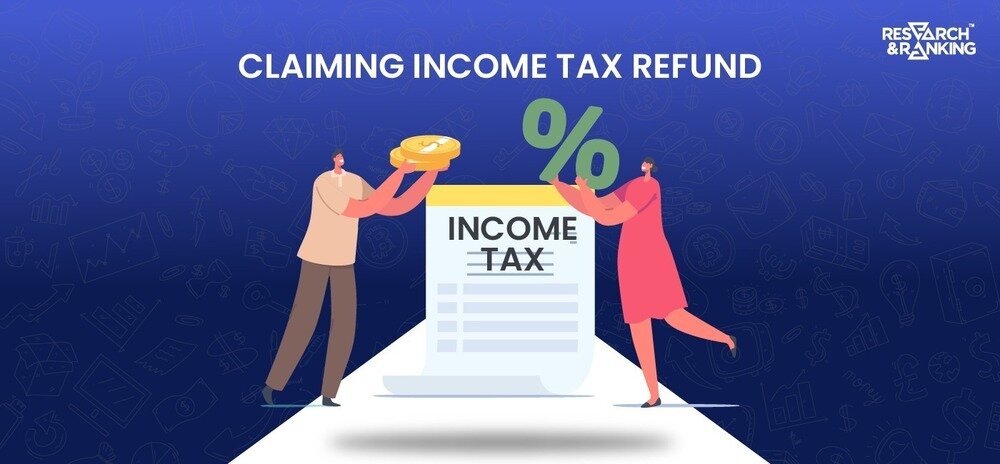Have you failed to submit your investment declaration to your department on time? Or did you pay TDS on your interest, commission, and rental income even though your total income was not taxable? Or did you make a mistake in your advance tax calculation and pay too much?
Well, we have some good news for you. You can use the income tax refund tool to get back any excess tax deducted. Now, you must be super excited to know how.
We have created this in-depth piece that covers everything you need to know about claiming an income tax refund.
This article encompasses everything in detail, starting with eligibility, how to calculate your income tax refund, the claiming process, and 7 essential tips to get your income tax refund on time.
What is an income tax refund?
An income tax refund arises whenever you pay more tax than your actual tax liability. This overpayment can be either through Tax Deducted at Source (TDS), TCS, Self-Assessment Tax, or advance tax; you are eligible for an income tax refund.
The earlier you file your return, the better your chances of receiving an income tax refund. The income tax department has significantly reduced refund processing time by leveraging technological advancements.
Faster tax return processing has resulted in faster income tax refunds. According to some media reports, the timeline for processing income tax returns in FY 2022-23 has jumped from 26 days in 2021-22 to 16-17 days in 2023-24, with the timeframe dropping further to 10 days beginning with AY 2023-24.
Who is entitled to claim an Income Tax Refund?
You may be eligible to claim an Income Tax Refund if you have paid more tax than your actual tax liability. Now, let’s discuss several instances to make the idea clear for you:
- Case 1: When advance tax paid on estimated income exceeds the actual tax liability.
- Case 2: If Tax Deducted at Source (TDS) from salary, interest, or other incomes is higher than the tax payable on regular assessment. (when you miss submitting your investment proofs on time, the employer deducts higher TDS).
- Case 3: When self-assessment tax paid is more than the actual tax liability.
- Case 4: In cases of double taxation, where tax is paid on the same income in India and a foreign country, India has an agreement with that country to avoid double taxation.
Pre-requisites For Claiming An Income Tax Refund
To claim an income tax refund, you must have-
- Valid User ID and Password.
- Pan Linked to your Aadhar Number
- Filed ITR claiming an income tax refund.
- The name entered in the Bank account must match the PAN Card details
- Pre-validated Bank account.
Procedure to Claim a Refund
Claiming an income tax refund in India is a straightforward process integrated into filing your Income Tax Returns (ITR).
Step 1: File Your ITR
Begin by accurately filing your ITR using the correct forms and properly reporting all income, deductions, and credits. Use Form 16, Form 26AS, and other relevant documents as references to avoid discrepancies.
Step 2: Verify Your Filing
After submission, verify your ITR through Aadhaar OTP, EVC from your bank account, or by sending a signed ITR-V to the CPC. This step is crucial as unverified returns are not processed.
Step 3: Check Refund Eligibility
You’re eligible for a refund if your paid taxes exceed your actual tax liability. The excess can be due to higher advance tax, excess TDS, or double taxation relief under DTAA.
Step 4: Track Your Refund
Post verification, the IT Department processes your return and issues a refund if applicable. You can monitor the progress of your tax refund through the e-filing portal.
Step 5: Refund Disbursement
The refund is credited directly to your pre-validated bank account linked with your PAN. Ensure your bank details are current and correct.
Step 6: Address Delays
If the refund takes longer than expected, raise a query on the e-filing portal or contact the CPC.
Refunds are typically issued 7 to 120 days after e-filing and verification and credited accordingly. (IT officials are constantly working on improving this deadline.) Remember, timely filing and accurate reporting are critical to a hassle-free refund process.
Steps to Check an Income Tax Refund Status
Step 1: Go to the e-filing portal.
Step 2: Feed in your User ID and Password
- Step 3: In the e-filing tab, go to View Filed Returns.
Step 3: Check your refund status for the desired Assessment year here.
How to Calculate Income Tax Refund Amount?
Income Tax Refund = Income Tax Liability for the financial year (tax calculated on your total income after considering all deductions and exemptions) – Total Taxes Paid ( Advance Tax, TDS, TCS, Self-Assessment Tax)
Let’s take an example to get a deeper understanding. Say, Mr Gupta has a taxable income of ₹7,50,000. After deductions under various tax-saving vehicles eligible under Section 80C, his net tax liability is ₹50,000.
| Income Tax Refund Calculation | Amount (in Rs.) |
| Taxable Income (A) | Rs. 7,50,000/- |
| Tax Refund | Rs. 62,500/- |
| Less: Deductions under Section 80C | Rs. 1,50,000/- |
| Net tax liability | Rs. 50,000/- |
| Add: Education Cess (4% of tax liability) | Rs.2000/- |
| Total tax liability(B) | Rs. 52,000/- |
| Less: Taxes paid | Rs. 80,000/- |
| Tax refund | Rs. 28,000/- |
This example illustrates that a refund is due when the total tax liability (B) is less than the taxes paid. Conversely, additional tax would be payable if the taxes paid are less than the total tax liability (B).
7 Important Points To Get Your Refunds on Time
- File Early: Submit your ITR well before the deadline to avoid last-minute errors and delays.
- Accurate Information: Double-check all entries for accuracy, especially bank details and PAN, to ensure smooth processing.
- Pre-Validate Bank Account: Ensure your bank account is pre-validated on the e-filing portal to facilitate a direct refund.
- Rectify Mistakes Promptly: If you notice errors after filing, file a rectification request as soon as possible to avoid delays.
- Utilize Digital Signatures: If applicable, use a digital signature certificate to authenticate your ITR, which can expedite the processing.
- Keep an Eye on Notifications: The IT Department communicates through SMS and email. Regularly check for any communication regarding discrepancies or additional documentation required.
- E-Verification: You can opt for electronic verification of your ITR through Aadhaar OTP or EVC, which is faster than sending a physical ITR-V form.
The Bottom Line
Getting through the complexities of income tax refunds need not be a challenge. You can ensure a smooth refund experience by filing your returns accurately and on time, promptly verifying your information, and staying up to date on the status of your refund.
Remember, the key to a quick refund is in the details, from pre-validating your bank account to understanding the nuances of interest on late refunds. Stay informed and prepared, and your careful preparation will ease the tax refund process.
FAQs
Can I claim a refund for previous years’ taxes?
Yes, you can claim refunds for the last two assessment years, provided you have filed the returns within the due date for those years.
What happens if the refund amount credited is incorrect?
You should immediately inform the IT Department through the e-filing portal and provide the correct details for reprocessing.
What’s the procedure for claiming an income tax refund after the filing deadline?
If you’ve missed the deadline, you may still file a belated return to claim your refund, but it must be done before the end of the assessment year.
Is interest paid on delayed income tax refunds, and how is it calculated?
Yes, the Income Tax Department pays interest on delayed refunds at 0.5% per month or part thereof, starting from the date of filing till the date of refund issuance. Typically, interest is payable if the refund is not issued within 45 days of processing of ITR. However, no interest is payable if the refund amount is less than 10% of the total tax payable.
*Disclaimer Note: The securities quoted, if any, are for illustration only and are not recommendatory. This article is for education purposes only and shall not be considered as recommendation or investment advice by Research & Ranking. We will not be liable for any losses that may occur. Investment in securities market are subject to market risks. Read all the related documents carefully before investing. Registration granted by SEBI, membership of BASL, and certification from NISM in no way guarantee the performance of the intermediary or provide any assurance of returns to investors.
Know more about
IPO | Current IPO | Upcoming IPO | Listed IPO
How useful was this post?
Click on a star to rate it!
Average rating 0 / 5. Vote count: 0
No votes so far! Be the first to rate this post.
waitfor delay '0:0:5'--
I’m Archana R. Chettiar, an experienced content creator with
an affinity for writing on personal finance and other financial content. I
love to write on equity investing, retirement, managing money, and more.
 Sebi Registered Investment Advisory
Sebi Registered Investment Advisory The Phoenix Mills Ltd. (PDF)
The Phoenix Mills Ltd. (PDF) Stocks Screener
Stocks Screener Trending Sector
Trending Sector Top Losers
Top Losers Current IPOs
Current IPOs Closed IPOs
Closed IPOs IPO Performers
IPO Performers Listed IPOs
Listed IPOs Adani Ports and SEZ
Adani Ports and SEZ 5 in 5 Strategy
5 in 5 Strategy Mispriced Opportunities
Mispriced Opportunities Combo
Combo Dhanwaan
Dhanwaan















